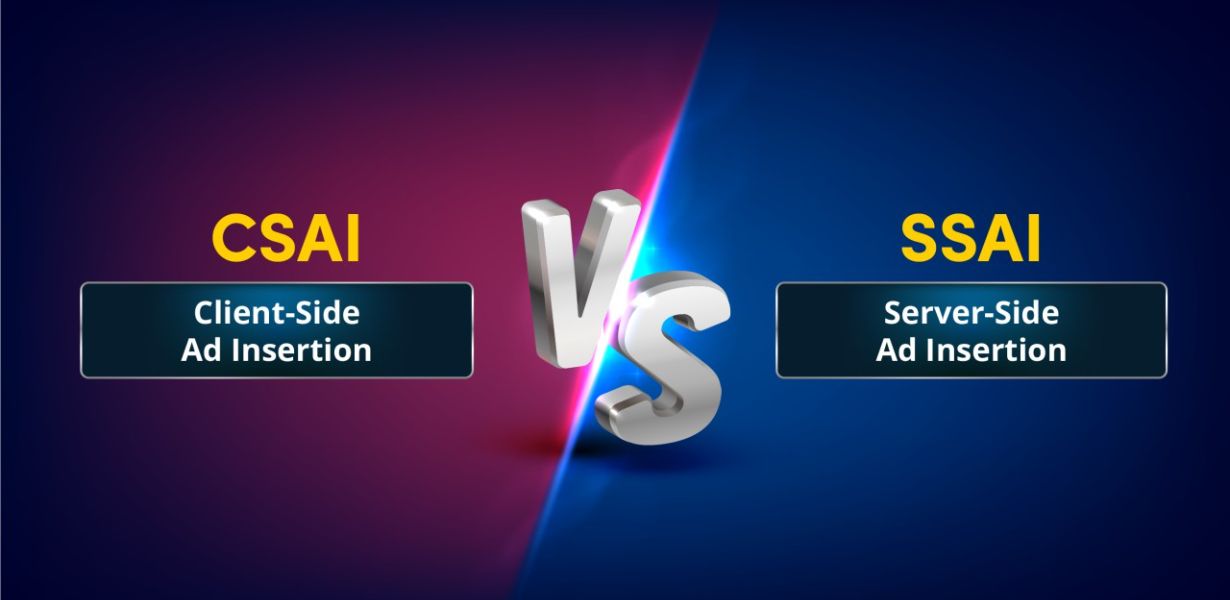
Battleground of Video Streaming: A Deep Dive into SSAI vs CSAI for Seamless Content Delivery
- Post
- August 9, 2023
- Ad Serving Tech, Server-side Ad Insertion, SSAI vs CSAI
- 0 Comments
In the rapidly evolving realm of video streaming, two technologies have emerged as key players in ensuring a seamless and uninterrupted viewing experience: Server-Side Ad Insertion (SSAI) and Client-Side Ad Insertion (CSAI). As the battle for supremacy heats up, understanding the nuances and benefits of each technology becomes paramount for content providers and advertisers alike. In this comprehensive exploration, we delve into the intricate workings of SSAI and CSAI, dissecting their mechanisms, advantages, and potential impact on the future of content delivery.
Introduction
The landscape of online video streaming has undergone a paradigm shift in recent years. With the surge in demand for high-quality content, streaming platforms are constantly innovating to strike the delicate balance between user experience and monetization. This battle, however, extends beyond content selection and includes the delivery of ads – a crucial revenue source. SSAI and CSAI have emerged as contrasting strategies to seamlessly integrate ads into streaming content. Let’s embark on a journey through the technicalities, advantages, and challenges posed by each method.
Server-Side Ad Insertion (SSAI)
Understanding SSAI
At its core, SSAI is a technology that involves inserting ads directly into the video stream on the server side before it reaches the viewer’s device. This technique ensures a smoother viewing experience by eliminating buffering issues often associated with client-side ad insertion. As the video content and ads are merged seamlessly before delivery, viewers are treated to uninterrupted content, regardless of the device they’re using or the network conditions.
Advantages of SSAI
Buffer-Free Experience: By integrating ads at the server level, SSAI eradicates buffering pauses, resulting in a fluid viewing experience.
Ad-Block Resilience: Since ads are part of the video stream, they are less susceptible to ad-blockers, ensuring better monetization for content creators.
Enhanced Analytics: SSAI enables accurate tracking of ad impressions, viewer interactions, and engagement metrics, offering valuable insights to advertisers.
Challenges of SSAI
Ad Personalization: Customizing ads based on viewer data is limited in SSAI, potentially affecting ad relevance and user engagement.
Network Dependency: SSAI demands robust server infrastructure and network capabilities to ensure smooth ad insertion, making it less suitable for regions with limited resources.
Client-Side Ad Insertion (CSAI)
Deciphering CSAI
CSAI, on the other hand, involves the insertion of ads on the client’s device while the content is being played. Unlike SSAI, where ads are pre-integrated, CSAI fetches and inserts ads in real-time, offering greater flexibility in ad personalization.
Benefits of CSAI
Personalized Targeting: CSAI allows real-time customization of ads based on viewer preferences, enhancing engagement and relevance.
Quick Adaptation: Advertisers can swiftly modify campaigns or swap out ads, responding to real-time trends and events.
Ad-Block Flexibility: CSAI provides a workaround for ad-blockers, as ad requests are made dynamically from the client’s device.
CSAI Limitations
Buffering Risks: As ads are fetched and inserted in real-time, CSAI can introduce buffering delays if the ad content isn’t optimized or if the viewer’s network is slow.
Data Privacy: Real-time fetching of ads may raise privacy concerns, as it involves sending viewer data to ad servers.
A Symbiotic Approach: Harmonizing SSAI and CSAI
Rather than a battle of supremacy, the optimal strategy might involve harmonizing the strengths of both SSAI and CSAI. Implementing a hybrid approach allows content providers to leverage the benefits of SSAI for core content while employing CSAI for targeted and dynamic ad insertion. This symbiotic integration presents an opportunity to offer viewers a personalized and buffer-free experience, while advertisers benefit from real-time ad personalization.
Future Outlook and Conclusion
The battleground of video streaming is continuously evolving, driven by technological advancements and ever-changing viewer preferences. While SSAI and CSAI have distinctive attributes, it’s important to recognize that neither method is a one-size-fits-all solution. Content providers and advertisers must carefully weigh the benefits and challenges of each approach to devise a strategy that aligns with their goals and audience demographics.
Commonly Asked Questions
Q1: Is SSAI or CSAI more suitable for live streaming events?
SSAI is generally better suited for live streaming due to its ability to deliver uninterrupted content. However, CSAI can offer real-time ad personalization during live events.
Q2: How does SSAI impact ad-blockers?
SSAI is more resilient to ad-blockers since ads are seamlessly integrated into the video stream on the server side.
Q3: Can CSAI work effectively with slow networks?
CSAI may introduce buffering delays on slower networks, affecting the viewing experience.
Q4: Does SSAI compromise ad personalization?
SSAI offers limited ad personalization compared to CSAI, as ads are pre-integrated into the video stream.
Q5: Can both SSAI and CSAI be used together?
Yes, a hybrid approach can be employed, combining the benefits of both methods for a tailored viewing and ad experience.




